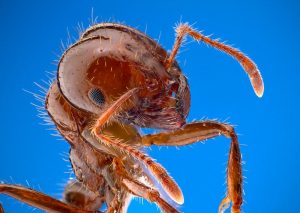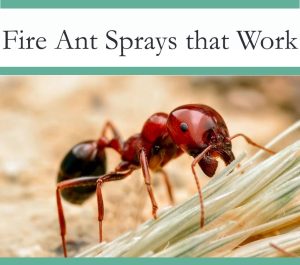Are Ants Dangerous?

Ants are everywhere. As one of the planet’s most successful species, these tiny creatures can be found in almost any environment. Every country on earth except Antarctica is home to numerous species of ant, and each of these types has its ecological role.
But are any of them dangerous? Well, yes. The world’s most dangerous ant is thought to be the bulldog ant. This aggressive insect lives in Australia. It has a sting in its abdomen which it doesn’t hesitate to use. The creature gets its name from its tenacity and unwillingness to give up during a fight. This ant stings multiple times, and if threatened, will attack in huge numbers, with the result that it can kill humans. Though to put things in perspective, this ant has been linked to three deaths since 1936.
There’s also the famous bullet ant, which takes its name from its bite, which is said to be as painful as being shot. This bug inhabits the jungles of South America and is capable of causing extraordinary pain when disturbed. However, while the effects of its bite are intense, they don’t last. As far as we know, no one has ever been killed by this ant despite the enormous amounts of pain they inflict.
Few of us will ever meet one of these exotic types of insect. Most of the bugs we do encounter are harmless. Ants are very clean insects and don’t carry any diseases. And the vast majority that humans regularly encounter aren’t capable of hurting us.
Ants are very clean insects and don’t carry any diseases.
However, there are some dangers associated with even relatively common species. Some ants that we regularly encounter in our homes and gardens can be dangerous to human health and property. This can happen in several ways as explained further below.
Different species are capable of different types of harm. In particular, fire ants deliver a painful sting that in certain situations, can be dangerous. Carpenter ants, on the other hand, create enormous amounts of property damage every year and are a significant cause of destruction to wooden buildings. Additionally, many types can inadvertently contaminate food by carrying bacteria on their bodies and spreading it wherever they go. Finally, there are invasive species, such as Red Imported Fire ant and Argentine ants, that are changing the natural balance of the places they’ve invaded.
This doesn’t mean that you need to be afraid of ants. Most species are not harmful to people and have no interest in humans beyond the food that we provide. But it’s important to be aware of the problems that these critters can cause. So let’s take a closer look at the biggest dangers that come from ants.
Ant Stings & Bites

Ants are omnivores, meaning they will eat a wide variety of food. They are a major predator of other insects, which can be beneficial for humans. But they also capable of scavenging far larger animals. Relative to their size, all ant species have powerful jaws.
But it’s not just their bite you need to worry about. Believe it or not, ants are closely related to wasps and bees. And like those flying creatures, some ants can and will sting. Just like wasps, they carry a pike in their abdomen which they used to inject venom. They use this to hunt down other insects, but will also use it in defence of the nest.
Some other species use a different method of chemical warfare. They will bite and then spray the wound they have created with formic acid from inside their bodies. This creates a stinging, burning sensation that can kill other insects, and can even be felt by humans. It’s estimated that of the approximately 12,000 ant species in the world, up to 70% of them engage in some form of chemical defense mechanism, whether it’s stinging or spraying acid.
Most of these creatures are confined to tropical environments. But not all. The fire ant, as its name implies, is capable of delivering a burning and painful injury. And it happily lives among us.
Fire Ants
Fire ants of various types are widespread across North America. The European type is an invasive breed that is most prevalent in the northeastern US, but it has also spread to the West Coast. Meanwhile, in the southern states, the red imported fire ant, or RIFA, has made itself at home after arriving from South America. So while the origins of this creature may be exotic, they are now widespread, especially in warmer climates.
When threatened, fire ants will bite into a person’s skin with their jaws, or mandibles. They will then plunge the stinger in their abdomen into the skin. At the same time, they will release a pheromone that tells all the other members of the colony that there is a threat in the area. As a result, this insect never attacked alone.
These stings can cause itchy welts. But in a certain percentage of the population, their alkaloid venom can cause more severe allergic reactions. In extreme cases, this can lead to anaphylactic shock, which can be fatal. It’s estimated that these creatures have killed over 80 people.
Fire ants can sting multiple times, their venom can be particularly dangerous to small children and pets.
Even worse, there have been cases where fire ants killed people that were no threat to their nest. There have been multiple instances of these creatures being found in hospitals and nursing homes. Patients in these institutions are often less able to endure the stinging of the pests, and in a few tragic cases, people have died.
Clearly, these creatures are dangerous. But it’s important to put the danger they represent into perspective. For most people, the sting of a fire ant is similar to that of wasp, and possibly even slightly less serious. The majority of healthy people will find the sting of one of these creatures little more than a painful nuisance, with no serious effects on long-term health. Still, if you have an allergy, the issue could be much more serious.
Maricopa Harvester Ant

There is another type of ant that, while less common, is even more dangerous to humans. The Maricopa Harvester ant is found mostly in Arizona, but there are also colonies in California, Colorado, Texas, Utah, Nevada, and New Mexico. And the venom this creature carries may be the most potent of any insect in the world.
Like the RIFA, Maricopa Harvesters sting by latching onto the skin with their mandibles and then deploying its stinger. This allows it to sting multiple times. And like the other species, this creature will also attract others to join in the attack. Similar in composition to the venom of a honeybee, the sting of the Maricopa Harvester is approximately 20 times stronger. It produces an intense burning pain that can last for hours. As few as 12 stings from this creature can kill a rat. And that’s without any allergic reaction taking place. A few hundred stings would be enough to kill a healthy human even without an allergy.
The sting of the Maricopa Harvester ant is approximately 20 times stronger than a sting from a honey bee.
Luckily, the species is not known to have caused any fatalities to date.
Property Damage

Far more common than physical harm is the damage these insects do to a property. And when it comes to property damage, there is one undisputed champion. The Carpenter ant is responsible for around $5 billion worth of damage to buildings each year in the US alone.
As North America’s largest species, Carpenter ants look fearsome. They get their name from their habit of nesting inside wood. While they often nest inside rotten and water damaged timber, they don’t have to. The jaws on this creature are powerful enough to chew holes even in solid wooden beams.
Given their powerful jaws, you might be wondering if Carpenters bite. Well, they can. They have enough power in that jaw to break human skin, and they also have the nasty habit of injecting formic acid into the wound they create. However, this is mercifully rare. Carpenters are not particularly aggressive and are unlikely to see you as a threat unless you are attacking their nest. If so, it’s a good idea to wear gloves and cover up to protect yourself from any bites from these powerful bugs.
But the damage these insects do to homes is by far the greater threat. Unlike termites, carpenter ants don’t eat wood. Instead, they carve out tunnels and galleries in which to place their eggs and create their nest. Over time, these holes will weaken the structure of the wood and could ultimately lead to collapse. Often, this damage goes unnoticed until a storm or some other event comes along. By the time the structural integrity of a building is found to be compromised by these insects, it may be too late.
Carpenter ants are extremely unlikely to cause a building to collapse by themselves. Usually, they are just one of a number of factors. Are these bugs going to bring your house crashing down around you? Probably not. So they may not be dangerous to you personally. But they can be extremely dangerous to your home and your bank balance, thanks to the cost of structural repairs.
Carpenters aren’t the only ones capable of property damage, though. Some ant species, such as crazy ants, are attracted to electricity. This leads them to crawl inside electrical equipment and touch the contacts on circuit boards. Sometimes, they even chew on wires. This can cause equipment to short-circuit and malfunction and in rare instances can also cause fires.
The ant’s social behavior exacerbates the problem. If an ant receives a shock, it will release a pheromone that tells others it’s being attacked. That will summon more insects to the equipment, which will also get electrocuted and release pheromones of their own.

Contamination

Ants are clean creatures. Because they live in such large colonies, they need to maintain hygiene. They do this by grooming themselves and each other, and by removing any potential contaminants from the nest. For this reason, they don’t spread disease the way some other bugs do.
However, ants, like anything else, are more than capable of carrying bacteria that can cause disease. One of the worst offenders in this regard is the tiny Pharaoh species, another invasive pest that has made itself at home in human dwellings. These bugs are of particular concern in hospitals, where they have been found to carry bacteria such as salmonella, Streptococcus, and Staphylococcus, among others. As omnivores, they are attracted to the same food that humans eat. So if an insect has been foraging somewhere dirty and then crawls over some food, it’s very easy for bacteria to be spread and contaminate the food.
But Pharaohs aren’t alone in this. The foraging activity of many ants brings them into contact with a wide variety of possible pathogens. So while the critters themselves aren’t considered major vectors of disease, they can cause a number of health complaints via the contamination of food. The best remedy is to keep all food sealed away where they can’t reach it, and to throw out any food items you feel may have been contaminated by the presence of bugs.
Ecological Harm
Say what you like about ants, you can’t deny they have their place in the world. Every single one of the 12,000 species evolved for a reason, to fill a particular niche in a specific environment. So you may not think that these bugs can harm the environment. They can, and they do.
In many ways, they are are the victim of their own success. Sometimes, they are a little too good at adapting to new environments. For proof, you don’t need to look any further than the many invasive species that can be found in North America. The previously mentioned Pharaoh, the European fire, the red imported fire ant – all of these creatures can be found a long way from the environment in which they evolved, and all have been remarkably successful at adapting to a new way of life.
Generally, human activity is to blame for this. Ant populations were once isolated by natural barriers such as mountains, rivers, and oceans. South American bugs had no realistic way of reaching North America. And it was impossible for them to cross the ocean. But that’s no longer the case. Human travel is responsible for the spread of numerous species. In a certain sense, we’re the best thing that ever happened to them.
But when these creatures arrive in a new environment, they can do a tremendous amount of harm. Local species are often unable to compete with them. They may find they have no natural predators in their new environment, and so there is nothing to stop their populations from blooming and upsetting the natural balance.
The RIFA first arrived in the US from South America in the early 20th century. Since then, they have a spread across 14 southern states, helped by increasingly warm weather and human transportation. Highly aggressive and territorial, they have been able to outcompete many native species. Additionally, they have been known to attack bird nests to consume eggs and young birds. They have significantly reduced northern bobwhite quail populations wherever they have been introduced, and are a major threat to many species of ground-nesting birds. They also attack mammals and have been known to kill newborn cattle.
But invaders don’t come any more successful than the Argentine species. These tiny creatures have managed to spread across the world, traveling between continents on human ships. Because these creatures are not aggressive toward one another, they form one gigantic global supercolony with billions of members. These insects have become incredibly successful wherever they have managed to settle, to the point that they have begun to wipe out other species.
Additionally, these creatures love to feed on the sweet secretions of insects such as aphids. To safeguard this food source, these invaders will aggressively protect the aphids. And aphids feed on plants. As a result, the presence of these Argentine invaders can lead to an explosion in the population of aphids, which therefore leads to an increased rate of plant damage and crop failure.
The Dangers of Ants
Most ant species are not particularly dangerous creatures. They’re tiny and most are incapable of harming humans.
But with any group of insects as diverse and specialized as this one, it’s not a surprise to find that some buck the trend. Some ant species can be aggressive, and some can indeed be dangerous to humans and animals. And it’s not just the physical harm from bites and stings that you need to worry about. Ants can also cause property damage, food contamination, and upset the natural balance of the environment. The same environment that feeds us.
So, while they may be tiny, these creatures should not be taken lightly.



